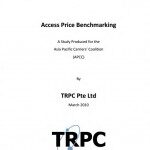 Access Price Benchmarking for APCC – a study produced for the Asia Pacific Carriers’ Coalition (APCC)
Access Price Benchmarking for APCC – a study produced for the Asia Pacific Carriers’ Coalition (APCC)
Executive Summary
1. This report follows similar APCC Access Benchmarking reports in 2003 and 2006. This report covers 14 economies, two more (Japan and Vietnam) than the 2006 report. The economies are:
Australia
China
Hong Kong
Indonesia
India
Japan
Malaysia
New Zealand
Philippines
Singapore
South Korea
Taiwan
Thailand
Vietnam
2. The 2006 report provided comprehensive data for leased lines and limited data for Ethernet access, but the data for DSL was insufficient to make comparisons. This report provides a sufficiently wide range of data for each category, which indicates the spread of the use of both Ethernet access and DSL.
3. The prices reported are not list prices but the prices actually paid by the seven respondent international carriers. However, it is not possible to judge from the data how representative overall they are of any particular economy. Clearly the actual prices will be influenced by, among other factor, discounts for bulk-buying and for strategic marketing purposes.
4. When making an assessment of price changes it is important to bear in mind changes in dollar exchange rates and local rates of inflation. This report on occasion uses deflators to translate from 2009 current or market prices to constant or real 2006 dollar prices for comparison purposes. A table of deflators is provided in Table 2.1.
5. The prices used for comparative purposes 2006-2009 are simple averages across all bitrates of leased circuits. This follows the practice of the 2006 report. There was insufficient data to weight these prices according to the number of circuits used in each bitrate category, but from the returns received it would seem that the outcome would show little difference.
6. Key issues are:
- Leased lines remain the most widely used leased circuits. With five notable exceptions (India, Malaysia, Philippines, Taiwan and Thailand) prices in real terms have fallen since 2006.
- Installation charges relative to the first year of rental appear to have changed little since 2006, rising marginally in some cases which may be an artifact of falling MRC (monthly recurrent charges). Mostly they are below 10% and in some cases waived, but in Australia, for example, they reach 32%.
- The demand for Ethernet access has not only continued to rise but the demand for higher bitrates is also rising, including 10 Gb/s. 12 economies are represented in the 2009 report compared with 11 in 2006. The 2009 report extends the coverage of the 2006 report to include point-to-point (P2P), point-to-multi-point contended (PMP) contended and uncontended.
- One country, Malaysia, stands out as being consistently charging the highest or second highest prices for Ethernet access. Thailand is overall the second highest. Unlike 2006, Singapore is no longer the most expensive but is consistently more expensive than Hong Kong, the lowest priced, by a factor of at least two or three.
- Reports of leasing DSL circuits came from more economies, 6 for symmetric and 8 for asymmetric, than in 2006 which reported from 5 economies. Hong Kong appears as the lowest priced for symmetric and Japan for asymmetric, but the appearance of China for the first time is significant.





